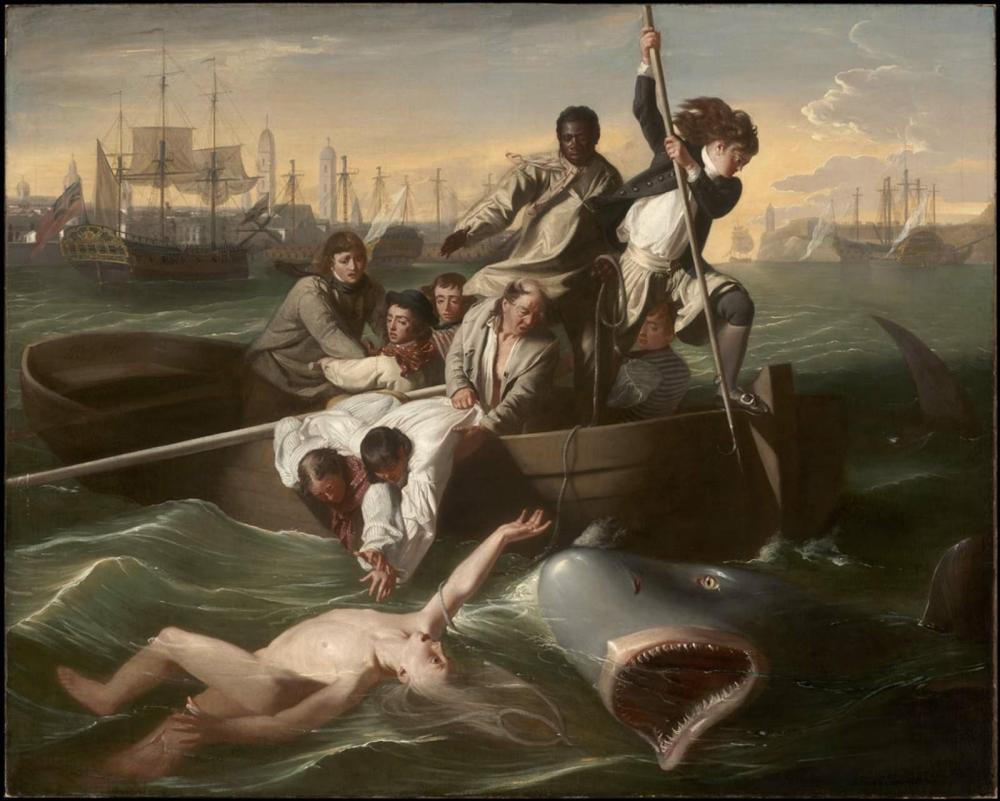Advanced Search
Watson and the Shark
John Singleton Copley (American, 1738–1815)
1778
Medium/Technique
Oil on canvas
Dimensions
183.51 x 229.55 cm (72 1/4 x 90 3/8 in.)
Credit Line
Gift of Mrs. George von Lengerke Meyer
Accession Number89.481
OUT ON LOAN
On display at Royal Academy of Arts, London, February 3, 2024 – April 28, 2024
On display at Royal Academy of Arts, London, February 3, 2024 – April 28, 2024
CollectionsAmericas
ClassificationsPaintings
John Singleton Copley departed from Boston in 1774 and traveled to Europe, where he spent a year studying Renaissance and baroque paintings and classical sculpture. After settling in London in 1775, he continued to paint portraits, but he also attempted more complex compositions. Watson and the Shark was the first large-scale history painting he executed. The dramatic composition depicts the attack of a shark on fourteen-year-old cabin boy Brook Watson in the waters of Havana Harbor in 1749. The heroic rescue was ultimately successful, but only after the youth lost the lower part of his right leg; Watson went on to become a prosperous merchant and hold numerous important political posts in London. Copley’s choice of subject was innovative, for tradition limited history paintings to themes from the Bible or mythology. Even when artists selected subjects outside the bounds of religious or classical narrative, they typically celebrated events of national rather than personal significance, such as military victories.
Copley’s boldness paid off, and Watson and the Shark established his reputation in England. His dramatic rendering of the climax of Watson’s story—the sailor thrusting a boat hook at the shark lunging with jaws agape at the helpless, terrified boy in the water while other sailors struggle to reach him—appealed to the English public. That Copley drew on old-master paintings by Raphael and Rubens for his composition, echoing their grandeur and themes of salvation, likewise found favor with his contemporaries. He was elected to full membership in the Royal Academy in 1779. His popular painting was made into a print for wider distribution to the public in 1779 and, proud of his accomplishments, Copley painted a second full-scale version of the painting that he kept to display in his studio. That version is the MFA’s picture.
This text was adapted from Elliot BostwickDavis et al.,American Painting[http://www.mfashop.com/9020398034.html], MFA Highlights (Boston: MFA Publications, 2003).
Copley’s boldness paid off, and Watson and the Shark established his reputation in England. His dramatic rendering of the climax of Watson’s story—the sailor thrusting a boat hook at the shark lunging with jaws agape at the helpless, terrified boy in the water while other sailors struggle to reach him—appealed to the English public. That Copley drew on old-master paintings by Raphael and Rubens for his composition, echoing their grandeur and themes of salvation, likewise found favor with his contemporaries. He was elected to full membership in the Royal Academy in 1779. His popular painting was made into a print for wider distribution to the public in 1779 and, proud of his accomplishments, Copley painted a second full-scale version of the painting that he kept to display in his studio. That version is the MFA’s picture.
This text was adapted from Elliot BostwickDavis et al.,American Painting[http://www.mfashop.com/9020398034.html], MFA Highlights (Boston: MFA Publications, 2003).
InscriptionsCenter left, inside stern of boat: J S Copley P. 1778-
Provenance1815, upon the artist's death, to his son, John Singleton Copley Jr., Lord Lyndhurst (b. 1772 - d. 1863), London; given by Lord Lyndhurst to artist's family, probably his sister, Elizabeth Clarke Copley (Mrs. Gardiner) Greene (b. 1770 - d. 1866), Boston [see note 1]. By 1882, Marrion Alice Appleton (Mrs. George von Lengerke) Meyer (b. 1862 - d. 1935), Boston; 1889, gift of Mrs. George von Lengerke to the MFA. (Accession Date: November 5, 1889)
NOTES: [1] Martha Babcock Amory (granddaughter of the artist), in The Domestic and Artistic Life of John Singleton Copley (Boston, 1882), p. 74, notes that the painting went to the artist's son, Lord Lyndhurst, who gave it to a "near relative [in] Boston" and then went to the "family of the late Charles Appleton." In 1850, "Mrs. G. Greene" lent a painting of Watson and the Shark to the Boston Athenaeum. It may be identical to the painting lent to the Athenaeum in 1841 under the name of her daughter, Susannah Copley Greene Hammond (b. 1805 - d. 1844) and in 1866 under the name of her son, Gardiner Greene Hammond (b. 1832 - d. 1903).
NOTES: [1] Martha Babcock Amory (granddaughter of the artist), in The Domestic and Artistic Life of John Singleton Copley (Boston, 1882), p. 74, notes that the painting went to the artist's son, Lord Lyndhurst, who gave it to a "near relative [in] Boston" and then went to the "family of the late Charles Appleton." In 1850, "Mrs. G. Greene" lent a painting of Watson and the Shark to the Boston Athenaeum. It may be identical to the painting lent to the Athenaeum in 1841 under the name of her daughter, Susannah Copley Greene Hammond (b. 1805 - d. 1844) and in 1866 under the name of her son, Gardiner Greene Hammond (b. 1832 - d. 1903).
ENG_304.mp3

















